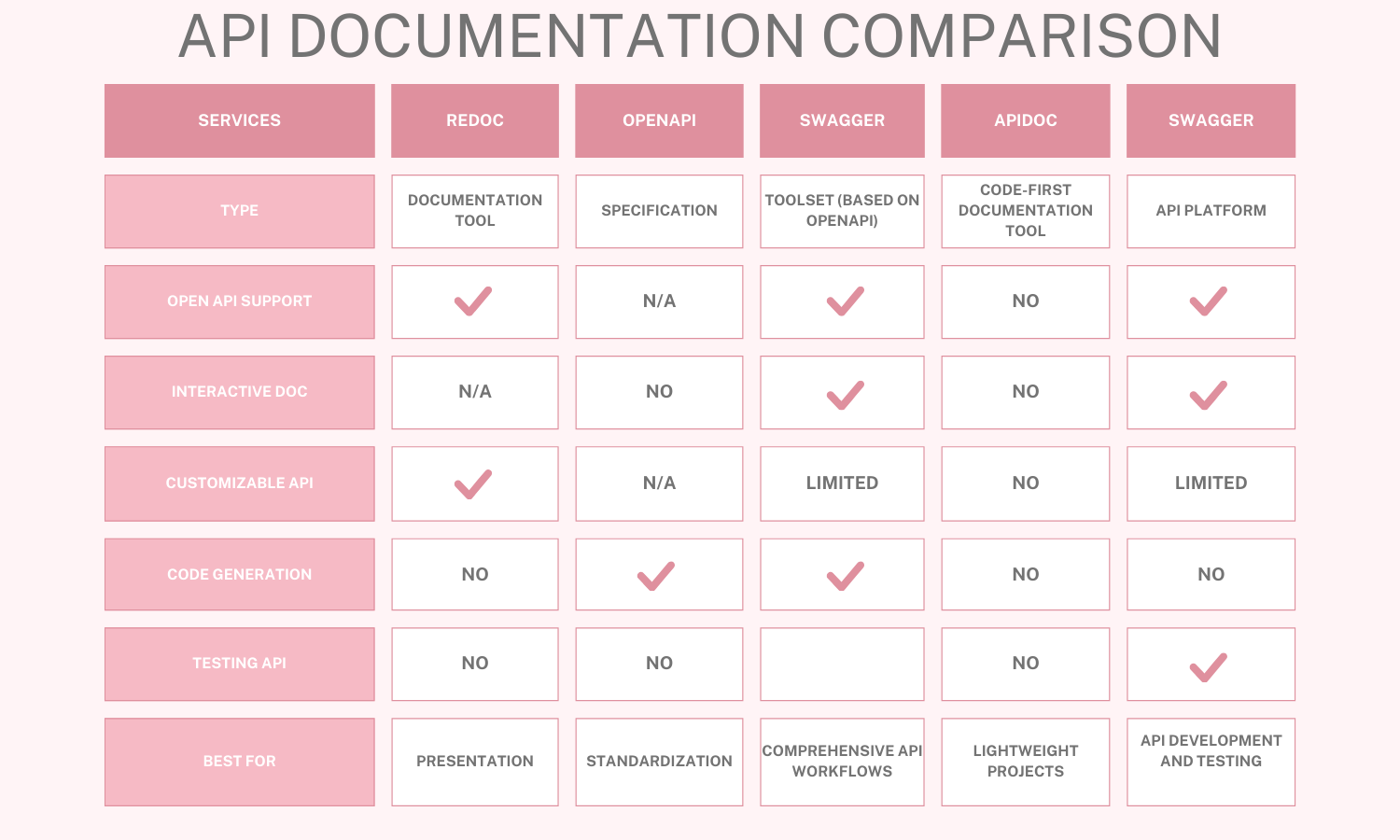Choosing the Right API Documentation Tool: Redoc, OpenAPI, Apidoc, Swagger, or Postman?
By khoanc, at: Jan. 3, 2025, 6 p.m.
Estimated Reading Time: __READING_TIME__ minutes


Today, having clear, well-organized, and interactive documentation is vital for developers and end-users to understand and utilize your API. However, with numerous options available, choosing the right API documentation tool can be challenging.
In this blog post, we'll discuss the differences between Redoc, OpenAPI, Apidoc, Swagger, and Postman, helping you make an informed choice based on your project needs.
Understanding the Tools
1. OpenAPI
-
What is it? OpenAPI is a specification for defining RESTful APIs. It provides a standard format (YAML or JSON) to describe the structure of your API, including endpoints, request/response formats, authentication methods, and more.
-
Use Case: OpenAPI is the backbone for tools like Swagger and Redoc. It’s the industry standard for creating machine-readable API specifications, making it easier to generate documentation, code, and testing tools.
-
Why Use OpenAPI?
- Universally accepted standard.
- Allows seamless integration with multiple tools.
- Provides a strong foundation for documenting complex APIs.
- Universally accepted standard.
2. Swagger
-
What is it? Swagger is a suite of tools built around the OpenAPI specification. It includes:
- Swagger Editor: Write and visualize your API specifications.
- Swagger UI: Generate interactive API documentation.
- Swagger Codegen: Generate server stubs and client SDKs.
- Swagger Editor: Write and visualize your API specifications.
-
Use Case: Swagger is ideal for developers who want to combine API design, testing, and interactive documentation in one toolset.
-
Why Use Swagger?
- Supports OpenAPI 2 and 3.
- Provides interactive documentation where users can test API endpoints.
- Enables both design-first and code-first approaches.
- Supports OpenAPI 2 and 3.
3. Redoc
-
What is it? Redoc is a tool specifically designed for rendering API documentation from OpenAPI specifications. It focuses on creating clean, responsive, and professional-looking documentation.
-
Use Case: Redoc is perfect for teams that already have an OpenAPI spec and need a customizable, static documentation site.
-
Why Use Redoc?
- Fully supports OpenAPI 3.
- Clean and user-friendly UI.
- Easily hosted anywhere (e.g., GitHub Pages, custom servers).
- Fully supports OpenAPI 3.
4. Apidoc
-
What is it? Apidoc generates API documentation directly from your source code comments. It’s not based on OpenAPI but uses inline annotations to describe endpoints.
-
Use Case: Apidoc works well for small to medium-sized projects and for teams that prefer a code-first approach to documentation.
-
Why Use Apidoc?
- Simple setup and lightweight.
- Automatically extracts information from your codebase.
- Supports multiple programming languages, including Python, Node.js, and PHP.
- Simple setup and lightweight.
5. Postman
-
What is it? Postman is a collaborative platform for API development. It allows you to design, test, and document APIs within a single tool.
-
Use Case: Postman is excellent for teams looking for an all-in-one solution for API development, testing, and interactive documentation.
-
Why Use Postman?
- Automatically generates API documentation from collections.
- Allows API testing and debugging alongside documentation.
- Simplifies team collaboration with built-in version control.
- Automatically generates API documentation from collections.
How to Choose the Right Tool?
Here’s a quick comparison table to help you decide:

Recommended Scenarios
-
When to Use OpenAPI:
If you want a standardized, vendor-neutral way to define and share API specifications, OpenAPI is the right choice. It’s a prerequisite for tools like Swagger and Redoc.
-
When to Use Swagger:
For a comprehensive API development workflow, including design, testing, and interactive documentation, Swagger is ideal. Its interactive Swagger UI is highly developer-friendly.
-
When to Use Redoc:
If your priority is creating polished, static API documentation with excellent presentation, Redoc stands out. It works best when you already have an OpenAPI spec.
-
When to Use Apidoc:
If you prefer a code-first approach where documentation is generated from inline comments, Apidoc is lightweight and easy to set up.
-
When to Use Postman:
For teams that need an all-in-one tool for API development, testing, and documentation, Postman is the best choice.
Conclusion
Choosing the right API documentation tool depends on your project’s needs and your team's workflow. Whether you're looking for a polished UI (Redoc), a complete toolset (Swagger), or a lightweight code-first approach (Apidoc), there’s a solution for every scenario. For teams needing an all-in-one platform, Postman offers unparalleled convenience.
No matter which tool you choose, investing in proper API documentation ensures better developer experiences, faster integration, and happier end-users.





